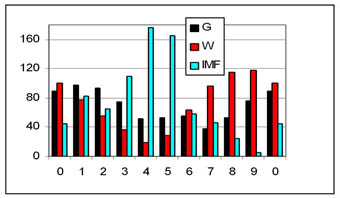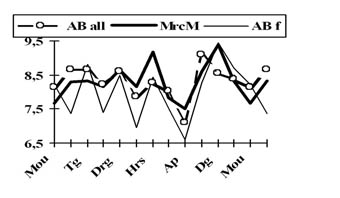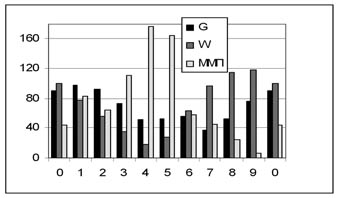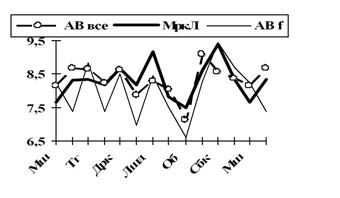
ON USING OF THE ASTRONOMIC INDEX
| Публикации |
| На главную |
| О себе |
| Контакты |
| Задания |
VII International Crimean Conf. «C0SMOS AND BIOSPHERE, Abstracts, Sudak, Crimea, Ukraine, 2007, P.118-119. (Об использовании астрономического индекса)
Olga D. Volchek, Saint Petersburg, Russian State Pedagogical University named after Herzen
It has been shown that the changing of lunar phases and of joint positions of the planets in the Solar system affects the intensity of the solar radiation. The Moon plays the main part in distribution of the solar energy upon the surface of the Earth. It also regulates cosmic and galactic radiation, electromagnetic fields and gravitational perturbations within the Solar system and on Earth (A.V. Klossovskiy, 1908; I.A. Komkov, 1972; A.L. Chizhevskiy, 1924; 1976; N.S. Sidorenkov, 2002).
It would be sensible to surmise that the 10-year cycle of the elements and the 12-year cycle of Zodiac signs in the solar-lunar Eastern calendar both are based on rhythms of astronomic phenomena. To discover them, all astronomical calendars and yearbooks from the end of XIX century till 1992 and other sources have been studied and analyzed. It appeared that there is a repetition in number of junctions of the planets with the Moon and the Sun. In particular, there is a significant difference (p?0,05; 0,005) in average annual quantity of junctions of Mercury, Venus, Mars, Jupiter and Saturn with the Moon and the Sun during new moon in different years of 10-year cycle, as well as of 12-year cycle, of the Eastern calendar. The probability of significant difference is much higher if the long-term stability of the Solar system is taken into consideration. The dynamics of changes in number of junctions of the planets of the studied cycles is synergic with the dynamics of indices
Any definite period in the Eastern calendar - either related to a Zodiac sign or an element – corresponds with a certain combination of planetary junctions and the indices W, G, IMF. It is illustrated in the pic.1 (O.D. Volchek, 1984, 1994).
It is known that the factors an organism faced in previous generations, as well as the repeating periods in geophysical processes, were reflected in genotype and stored in the evolutional program of development of organisms (A.P. Dubrov, 1990; B.A. Nikityuk, 1982). It is sensible to suppose that the repetition of weather on Earth, in its connection to planetary constellations, was also recorded in the genetic memory of organisms in the course of evolution. Fluctuations of gravity can serve as an informational sign to living systems about long-term perspectives of weather changes, which provides anticipation of reality and triggers adaptive mechanisms. It was reflected in the centuries-old observations with the focus on “the main planets”, weather conditions and psychophysiological characteristics of people in accordance with the cycles of the eastern calendar (T.P. Grigoryeva, 1975; V.A. Pronnikov, I.D. Ladanov, 1985; P.A. Startzev, 1961;V.P. Shestakova, 1967). Consequently, quantity of junctions of the planets with the Moon and the Sun can be used as the geocosmic index (the real picture of astronomic events is much more complicated).
Effectiveness of using the index was proved with the intensive correlations between the numbers of planetary junctions, corresponding to the year of birth or to the previous year, and the annual average indices of personal characteristics in question. For example, see pic.2 (O.D.Volchek, 2006). The extremes in number and intensity of such correlations go along with 10-year cycle. It is no wonder that the Chinese calendar pays more attention to this cycle, which is primary in relation to 12-year cycle (P.A. Startzev, 1961).


Pic. 1 (left) The variations of the indices G (tidal power), W (solar activity) and IMF (interplanetary magnetic field) for the10-year cycle of elements in the Eastern calendar. Y-direction: the value of the geocosmic indices. X-direction: years of the10-year cycle in the eastern calendar (0,1 – the element of metal; 2,3 – of water; 4,5 – of wood; 6,7 – of fire; 8,9 – of soil).
Note: the value of IMF is multiplied by 1000. Years of the elements in the Eastern calendar relate to those, which number ends with the corresponding figure: 0 and 1 – for the element of metal, 2 and 3 – for the element of water, and so on.
Pic. 2 (right) The correlation between the percentage of people with AB blood type and the number of junctions of Mercury and the Moon (MrcM index) at new moons in the year of birth, according to 120year cycle of the Eastern calendar. Y-direction: the percentage of people with AB blood type (“AB all” – for both men and women, “AB f” – for women) and the index MrcM (the number of junctions of Mercury and the Moon). The correlation significance is: for MrcM and “AB all” r=000,607, for MrcM and “AB f” r=0,708. X-direction: the names of years according to 12-year Zodiac cycle.
ОБ ИСПОЛЬЗОВАНИИ АСТРОНОМИЧЕСКОГО ИНДЕКСА
Волчек О.Д., Санкт-Петербург, РГПУ им. А.И.Герцена
Показано, что смена фаз Луны, изменения в совместном положении планет Солнечной системы отражаются на величине потока солнечной радиации. Луна является основным помощником в распределении солнечной энергии по поверхности Земли, регулятором космического и галактического излучений, электромагнитных полей, гравитационных возмущений в пределах Солнечной системы и на Земле (А.В.Клоссовский, 1908; И.А.Комков, 1972; А.Л.Чижевский 1924; 1976; Н.С.Сидоренков, 2002). Логично предположить, что в основе 10-летнего цикла стихий и 12-летнего цикла знаков Зодиака солнечно-лунного Восточного календаря лежат ритмы астрономических явлений. Для их поиска были изучены и проанализированы все астрономические календари и ежегодники с конца XIX века по 1992 год, другие источники. Обнаружена повторяемость численности соединений планет с Луной и Солнцем. А именно, среднегодовые значения числа соединений Меркурия, Венеры, Марса, Юпитера, Сатурна с Солнцем или Луной в период новолуний в разные годы 10-летнего, 12-летнего циклов по Восточному календарю достоверно различаются, p?0,05;0,005.С учетом стабильности Солнечной системы для длительных периодов достоверность различий значительно выше. Динамика численности соединений планет изученных циклов синергична с динамикой показателей потенциала долгопериодной части приливообразующей силы Луны и Солнца - G, и вариациями межпланетного магнитного поля – ММП; p?0,05;0,005. Конкретному периоду по Восточному календарю, знаку Зодиака или стихии, отвечает определенное сочетание показателей соединений планет; индексов W, G, ММП, что иллюстрирует рис.1. (О.Д.Волчек, 1984, 1994).
Известно, что факторы, с которыми в предшествующих генерациях организм сталкивался, повторяющаяся периодичность геофизических процессов отразились в генотипической памяти, закрепились в эволюционной программе развития живых организмов (А.П.Дубров, 1990; Б.А.Никитюк,1982). Логично предположить, что и повторяемость погоды на Земле в связи с планетными констелляциями зафиксировалась в ходе эволюции в генетической памяти живых организмов. Гравитационные флуктуации могут служить информационным сигналом для живых систем о масштабной перспективе погодных изменений, обеспечивая опережающее отражение действительности в деятельности их адаптационных механизмов. Это отразилось в многовековых наблюдениях относительно «главных планет», погодных условий, психофизиологических характеристик человека в связи с циклами восточного календаря (Т.П.Григорьева, 1979; В.А.Пронников, И.Д.Ладанов, 1985; П.А.Старцев, 1961; В.П.Шестакова, 1967). Следовательно, численность соединений планет с Луной и Солнцем может использоваться как геокосмический индекс (реальная картина астрономических событий намного сложнее).
Использование данного индекса показало его эффективность, когда на показатели численности соединений планет, соответствующие году рождения или предшествующему ему году, и искомые среднегодовые показатели человека приходятся выраженные корреляционные зависимости, пример на рис.2. (О.Д.Волчек, 2006). Их максимальное число и выраженность отвечают десятилетнему циклу. Неслучайно, ему уделяется большее внимание в китайском календаре, он первичен по отношению к 12-летнему циклу (П.А.Старцев, 1961).


Рис.1. (слева). Вариации усредненных значений индексов приливной силы G, солнечной активности W, межпланетного магнитного поля ММП для 10-летнего цикла стихий Восточного календаря. По ординате значения геокосмических индексов, по абсциссе – годы 10-летнего цикла восточного календаря: 0,1 – стихии металла; 2,3 – воды; 4,5 – дерева; 6,7 – огня; 8,9 – земли. Примечание: значения ММП увеличены в 1000 раз. Годам стихий Восточного календаря соответствуют годы по европейскому календарю, оканчивающиеся соответствующей цифрой: 0 и 1 для стихии «металла»; 2 и 3 – «воды», и т.д.
Рис.2. (справа). Сопряженность численности фенотипа крови АВ с динамикой соединений Меркурия с Луной (МркЛ) в дни новолуний для года рождения по 12-летнему циклу восточного календаря. Условные обозначения: по шкале абсцисс названия знаков Зодиака; по шкале ординат численность в % фенотипа АВ: «АВ все» - независимо от пола, «АВ f» - для женщин. Значения r: между МркЛ и «АВ все» r= 0,607; МркЛ и «АВ f» r= 0,708.